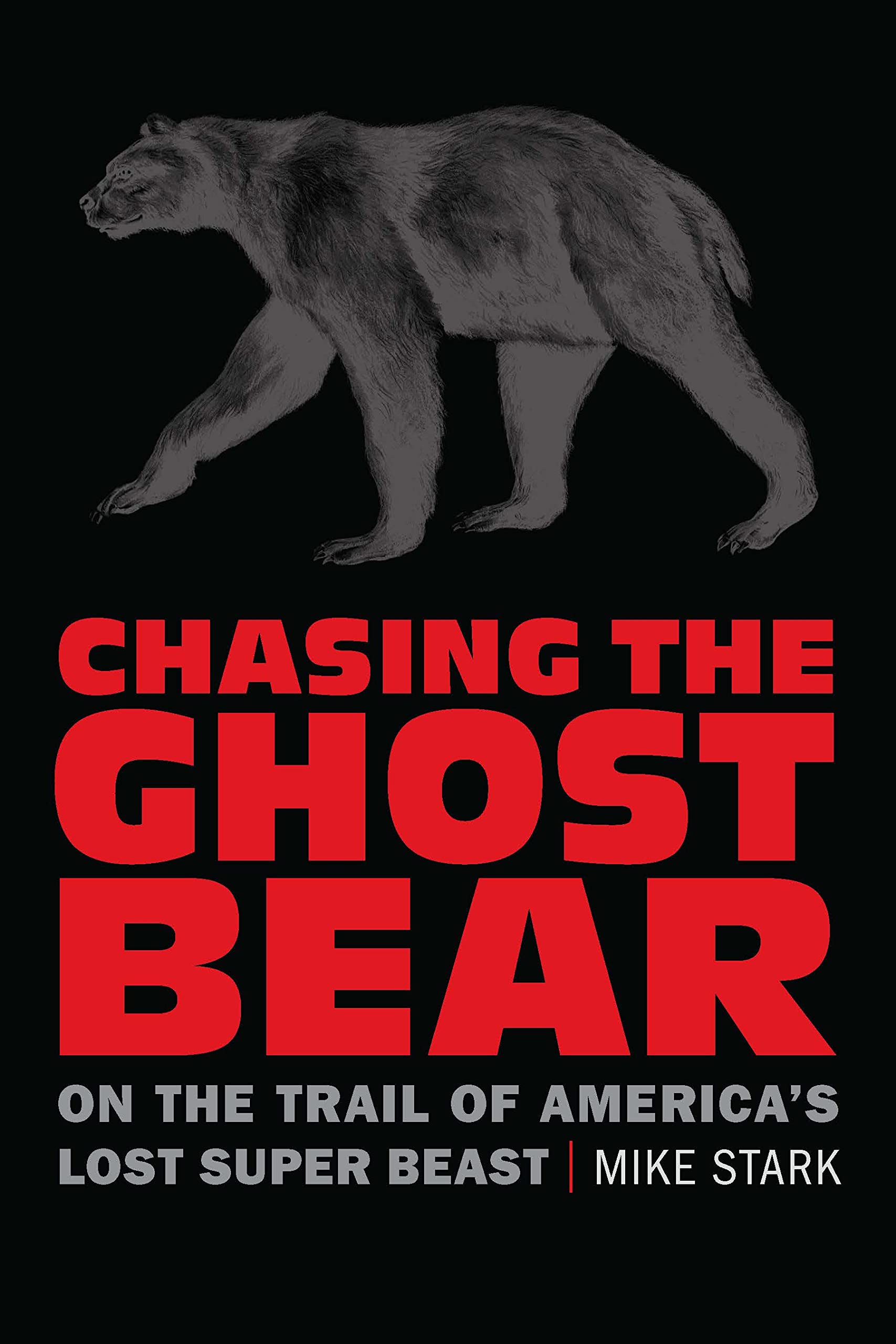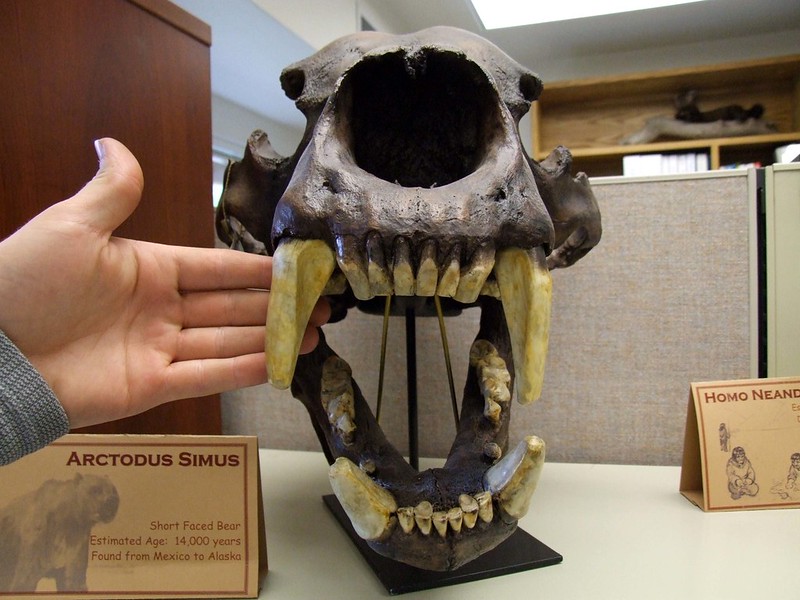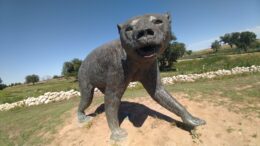Excerpted from Chasing the Ghost Bear: On the Trail of America’s Lost Super Beast by Mike Stark by permission of the University of Nebraska Press. ©2022 by the Board of Regents of the University of Nebraska.
Editor’s Note: Giant short-faced bears (Arctodus simus) went extinct some 11,000 years ago. These massive animals, which stood 10-feet-tall on their hind legs and weighed nearly a ton, vanished near the end of the Pleistocene. The Center for Biological Diversity’s Mike Stark brings their story back to life — and helps illuminate the cost of today’s extinction crisis.
On August 8, 1988, a man named Chris Nielson was digging with a backhoe as part of a reconstruction project for Huntington Reservoir in Utah’s Wasatch Mountains. Out of the sticky mud he pulled what looked to be a log. A closer examination revealed that it was actually a bone. A very large one. It turned out to be a front leg of a fifteen-foot-tall Columbian mammoth. Part of a long, curved tusk was also found. To the crew’s credit, work halted and a concerted excavation began. That summer about 90 percent of the mammoth’s skeleton was found during a meticulous recovery process. It was in remarkable shape, thanks mostly to the encasement of mud that had hovered around freezing for thousands of years, acting as the perfect refrigerator — and preservation agent — for this ancient mammoth.
“At the excavation it was so fresh that we thought we could smell rotting meat at one place,” said David Gillette, who was Utah’s state paleontologist at the time.
Based on the wear and tear of its teeth, the big bull mammoth was likely around sixty years old — granddaddy age for an elephant. It was no charmed life on the edge of this receding alpine lake. Nearly all of his bones showed signs of severe and painful disease, mostly arthritis. The partially digested food in his intestinal tract revealed that his last meal was meager and thin, mostly needles and twigs from a fir tree, sedge leaves and seeds. Finally, around thirteen thousand calendar years ago — a point representing “the very end of mammoth existence in America” — he keeled over and died in a mud bog atop this mountain, far from his ancestral home.
Columbian mammoths were typically plains dwellers, so it was unusual to find one in the mountains at nine thousand feet above sea level. (At the time it was the highest mammoth skeleton ever found in North America.) But, when he died, the Pleistocene and the continent’s mammoth species were in their twilight as the climate was getting warmer. It’s likely the Huntington mammoth was moving upslope in search of cooler climes in the upper reaches of the Wasatch Mountains. But he wasn’t alone.
Several projectile points were also found at the dig site, leading to speculation that Paleoindians may have either hunted the mammoth or scavenged it after finding it dead.
Word got out about the mammoth in 1988 and soon locals were sneaking onto the site and digging on their own, even though it was on federal land and they didn’t have permission. A crew was called in to guard the area. That’s apparently when the remains of a giant short-faced bear were found and whisked away: a single rib and part of its skull, including several teeth. The story was that someone on the night watch duty took the bear parts and stowed them in a refrigerator. They were eventually returned, but the damage was done. Situational context is crucial in paleontological digs, and removing pieces before their location can be closely documented is like ripping pages from a book and trying to understand what they mean. Although the bear bones were recovered and placed safely in a museum the physical context, including exact proximity to the mammoth and the human tools, was lost forever.
Still, there was enough to scientifically piece together some of the story of this giant short-faced bear by Gillette, the Utah paleontologist, and David B. Madsen, both of whom worked at Utah’s Division of State History. First of all, it was big, likely in the same ballpark of the giant found in the early 1980s near ancient Lake Bonneville that was estimated to weigh around 1,400 pounds. The Huntington bear also had large teeth, a tall nasal cavity and an exceptionally squished snout. “This individual was distinctly short-faced, an extreme among the short-faced bears,” Gillette and Madsen wrote.
And then there was the matter of the projectile points and other lithic tools found nearby. Some of them were similar to points found in western Wyoming from around 9,500 years ago. Others were comparable to those found higher up in the Rocky Mountains of the same vintage, if not a bit older. Could it be that, at this ancient lake, the mammoth, the bear, and the people were existing contemporaneously, each in their own desperate struggle for survival in a changing world? Maybe.
“The presence of these Paleoindian materials suggests, but cannot prove, that humans were contemporary with the Columbian mammoth and the short-faced bear at the Huntington dam site,” Gillette and Madsen said.
Utah has long been a hotbed for Ice Age wildlife discoveries. About two miles away from the Huntington Reservoir, there’s a site where American mastodons, extinct bison, and extinct horses have been found. About sixty miles north there’s another rich Pleistocene find. Silver Creek, as it’s known, includes twenty-nine species, like mastodons, ground sloths, dire wolves, saber-toothed cats, camels, horses, and bison. The date there is from about forty thousand years ago. But what happened at Huntington may have been a final dramatic chapter in the final hours of the late Pleistocene. “I’m guessing Arctodus was feeding on our poor, dear mammoth,” Gillette, the state paleontologist, said at a community meeting a couple months after the discovery. “Perhaps it delivered the final blow.”
It’s hard to know for sure, but the frozen dead mammoth, so well preserved in the cool boggy ground, might’ve been one of the last meals of the Huntington bear. Gnaw marks on one of the mammoth’s wrist bones show a groove that matches the size and teeth arrangement of the bear. State officials later revised what they think happened: “It’s possible that the bear fed on the carcass and died at the same place,” they said.
Or it’s possible that a different short-faced bear had dined on the mammoth. It’s certainly not out of the question. Years later, scientists published a paper after examining mammoth remains found near Saltville, Virginia, with “extreme examples of carnivore gnawing.” The mammoth had died, and its carcass was probably partially submerged in water or mud. And then a wolf and another meat-eating scavenger — possibly an American lion or a giant short-faced bear — had come along and gnawed on its heel bones with enough force to be identified by scientists thousands of years later.

Arctodus simus remains, including parts of its jaw and a fearsome-looking lower canine, had been found nearby. The exact size of the bear is unknown, but there was enough evidence to say it was large and likely quite capable of stealing and defending any carcass coveted by other, smaller scavengers. “In fact its only likely rivals would’ve been larger members of its own species,” said the paper, which was authored by Blaine Schubert and Steven C. Wallace at East Tennessee State University.
Still there was another dimension to the bear at Huntington that had caught my eye. “This individual was one of the last of the Pleistocene megafauna in North America,” a state report said in 1996, “perhaps even the last generation.”
While the date may be in dispute — Schubert has since calculated that the Huntington bear lived sometime between 12,764 and 13,058 calendar years ago — the thought of a final, lonely bear, whether at Huntington or elsewhere, struck a melancholy note within me.
_______
This may have been the last stop for the giant short-faced bear. Of course it’s extremely unlikely, astronomically so, that the exact bear found at Huntington Reservoir was the last one on Earth — what are the odds that the last one would actually be found? And that we could ever make that determination? Still, somewhere the last of its kind dropped dead and when it fell, the great shroud of extinction descended over a species that had inhabited the planet for more than a million years. Strange as it was, I let myself consider the possibility that the final moments for Arctodus simus had ticked away at the top of this mountain, the very place I was standing in the chill of the first day of summer.
In recent years, a term has been coined to signify the final individual of a species: an endling. It’s an oddly charming term that’s poignant and sorrowful and final. I wondered if this Huntington bear was the endling for giant short-faced bears. Had his final meal, and the final meal for his kind, been eaten here? Had he spent years searching in vain for a mate, driven by the indefatigable pursuit of procreation at all costs? Had he wandered into the mountains in a last-ditch attempt to outlast the changing world around him only to find a sickly mammoth on the same lost and doomed path?
And then I wondered why I cared about this particular bear. Surely thousands upon thousands of A. simus had perished on the continent, so maybe this one should matter no more than those. But for whatever reason it did. The mind does funny things, and while I stood for a few minutes in the little covered pergola, I ticked through some of the other endlings I knew.
Martha was the name of the last of the passenger pigeons, a species once so populous that when flocks of hundreds of millions flew overhead, day turned to dark. They were mostly gone by the turn of the twentieth century. Martha was born in captivity, spent twenty-nine years at the Cincinnati Zoo, and died in 1914, taking all of the species’ genetic and cultural information with her.
Benjamin was the name given to the world’s last Tasmanian tiger, a sleek carnivorous marsupial with tiger stripes and a kangaroo pouch. He was captured in the wild and held at Australia’s Hobart Zoo under less-than-favorable conditions. He died in 1936, just months after a ban on hunting the species was put into place. Since then, though, there’s been considerable debate about whether Ben was actually the last of his kind.
I was always fond of Toughie, the last of the Rabbs’ fringe-limbed treefrogs. Originally from Panama, he spent his last years living alone at the Atlanta Botanical Garden, a sort of stately but tragic ambassador of the story of frog extinctions happening around the world. He died in 2016.
And it’s hard not to love Lonesome George, the last Pinta Island tortoise, a giant tortoise subspecies, from the Galapagos Islands. He lived to be more than one hundred years old, was never able to breed, and died in 2012, possibly of a heart attack.
It’s a mournful record but only a fraction of the extinctions that have happened during our lifetimes. Many went unnoticed, and nearly every endling went unnamed and uncelebrated. What name would we have given this Arctodus endling in the Utah mountains if we knew indeed he was the last? Huntington? Wasatch? Björn?
Without a good answer, I walked back up the hill to the car, pausing to take in the long stands of aspens and, at their feet, the snowfields stubbornly hanging on against the season’s change, the same way a child clings to a parent’s legs when trouble is afoot. I drew in a long breath of the thin mountain air and let it go. Nothing really lasts.
©2022 by the Board of Regents of the University of Nebraska. Published with permission.


